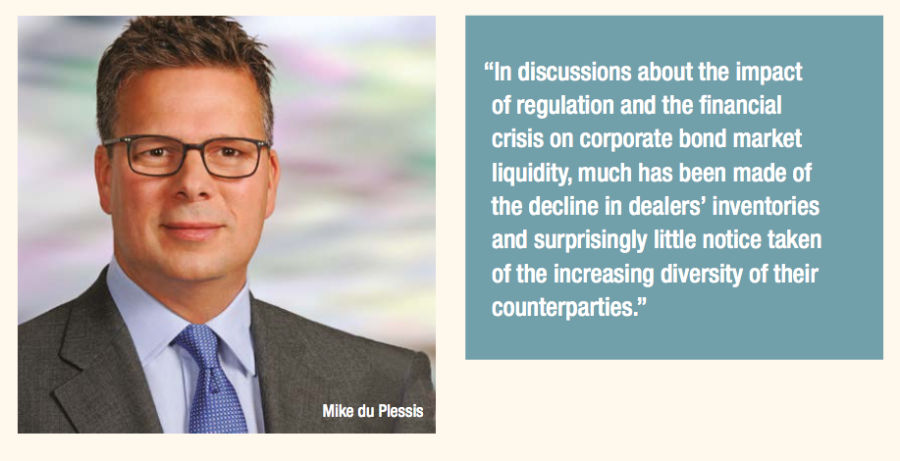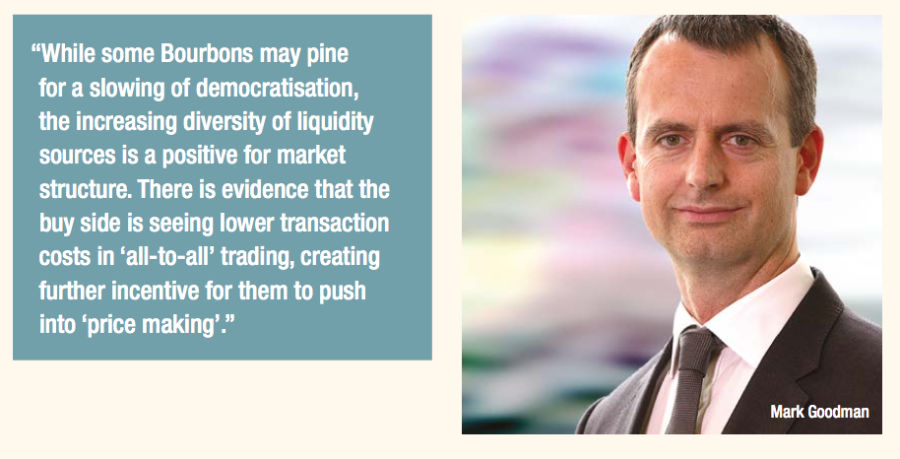Securing the benefits of the markets’ democratic revolution.
By Mike du Plessis, Managing Director, Global Head FX, Rates and Credit Execution Services and Mark Goodman, Managing Director, Global Head of Electronic Execution – FX, Rates and Credit at UBS Investment Bank.
A simple definition of democracy is rule by the many instead of a privileged few. By that definition, global markets are going through what amounts to a democratic revolution.
As with many revolutions, its seeds can be found in economic crisis. Before the global financial crisis, an ‘aristocracy’ of large international banks accounted for nearly all the business of providing liquidity for the trades of global asset managers. This aristocracy upheld a class division. On one hand was an ‘inside market’ in which the aristocracy traded amongst themselves. On the other hand was the dealer-to-client market, where the aristocracy interacted with the buy-side citizenry in bilateral, over-the-counter trading. Both markets depended on the telephone and instant messages.

The post-crisis story is well known: Higher capital requirements and new regulations prompted the ‘aristocrats’ to become more selective in their market-making activities and pare back principal trading. Also driving their strategic changes was a prolonged period of low interest rates and low volatility that made market-making profits harder to come by.
Investment banks remain critically important sources of liquidity, market access and expertise in global markets, and they continue to have the leading role in the primary market. But the reduced market-making presence of this aristocracy and the increasing electronification of the credit markets opened the way for democratisation of secondary trading, a process that has begun to erode class distinctions.
The most significant evidence of democratisation is the arrival of ‘all-to-all’ electronic trading protocols in which asset managers become distributors of liquidity rather than solely ‘takers’ of liquidity. This constitutes ‘price making’ rather than ‘market making,’ but the all-to-all model looks likely to continue to gain traction with a significant portion of the buy side.
A Greenwich Associates survey of 58 large institutions a year ago found that nearly 60% of investors consider themselves to be “a viable source of additional liquidity in the market, with long-only asset managers the most bullish on the idea.”1 Beyond the largest asset managers, “all-to-all” protocols have made it easier for other specialised players, such as proprietary funds and regional broker-dealers, to trade on a more equal footing with bigger institutions.

Another study in early 2016 estimated that 14 electronic platforms offer as many as 26 trading protocols in the ‘all-to-all’ category.2 The research found that in the first quarter of 2016 that more than 1,700 of the largest corporate bond issues had two-sided quotes on electronic platforms every day of the quarter. Contributing to this democratisation process has been the surge of assets into fixed-income ETFs, which have become liquidity proxies for credit instruments.
This process has reshaped investment banks’ trading business in ways not fully appreciated in some quarters. In discussions about the impact of regulation and the financial crisis on corporate bond market liquidity, much has been made of the decline in dealers’ inventories and surprisingly little notice taken of the increasing diversity of their counterparties.
FINRA reported last year that dealers are interacting with a larger group of counterparties today than before the financial crisis. In 2007, the top 10 dealers traded with an average of 245 counterparties. By 2015, the top ten’s average counterparty network had risen to 287. Said an IOSCO report: “It is possible that this increase in network size reflects, in part, reduced costs in identifying new counterparties through, for example, better technology.”3
While some Bourbons may pine for a slowing of democratisation, the increasing diversity of liquidity sources is a positive for market structure. There is evidence that the buy side is seeing lower transaction costs in ‘all-to-all’ trading, creating further incentive for them to push into ‘price making’.
Although the potential benefits are clear, concerns about the durability of this budding democratic trend are justified. The trend is still in its early stage. Electronic trading in corporate bonds is growing steadily but still accounts for only about 20% of US investment grade bond trades by value.
What would a ‘democratised’ market look like should the percentage share of electronic trading double, and an even more varied range of liquidity sources have access to the networks? It’s worth asking what impact this would have on markets’ ability to absorb interest rate or other types of shocks, including events involving errant technology, such as a ‘flash crash’.
As in all revolutions, without thoughtful leadership, this nascent democracy could veer off into the chaos of ochlocracy, misrule by the rabble. The question becomes, how can the sell side help make the move to a democratic market model sustainable and beneficial for their clients and themselves? It’s worth sizing up these challenges in the context of the four pillars of democracy enunciated in the French Revolution:
Justice for all: At this stage, the global regulatory framework reflects more of the traditional order than the emerging new order. As democratisation proceeds, the regulatory framework will have to take into account the buy side’s changing role in price formation and how that aligns with its fiduciary obligation. Standards of best execution could undergo significant changes. The sell side’s challenge will be to help clients adjust to changing standards in an increasingly electronic market with more diverse pools of liquidity spread across multiple trading platforms.
Equality of opportunity: Regulators’ oft-stated goal is to create a level playing among market participants, giving all equal opportunity to access liquidity. With liquidity spread among multiple electronic platforms – and with voice continuing to play a significant role in the market – the sell side has an important role in providing clients a comprehensive, aggregated view of trading opportunities, along with the capacity to execute transactions in a speedy, cost-efficient manner.
Freedom of speech and movement: In the emerging ‘all-to-all’ model, the buy side is no longer limited to the views of dealers when seeking out liquidity for a trade. In its move to ‘making a price’ as opposed to ‘taking a price,’ the buy side has asserted its freedom to express its views and initiate transactions. The sell side has a role to play in advising clients on their process for arriving at that view, and deciding on the best venue and strategy to capitalise on it.
Representation: Democracy can be messy. Connecting with multiple pools of liquidity across several different platforms with varying rulebooks risks becoming costly and inefficient for even sizeable global asset managers. At the same time, automated trading techniques developed in other asset categories are rapidly being applied to less liquid asset categories. In this environment, buy-side players will find value in being “represented” by a sell-side institution that can streamline market access and execution, as well as provide expertise on automated trading strategies.
As George Bernard Shaw observed, “Democracy is a device that ensures we shall be governed no better than we deserve.” The sell side’s challenges are clear, as it adjusts to the realities of the new market structure.
But the buy side too finds itself with a new set of obligations and responsibilities. Becoming an effective ‘price maker’ will require a fresh approach to trading, rippling out through technology, risk management and compliance. Significant strategic changes will be needed on both sides to secure the benefits of a ‘democratised’ market structure.
References:
- Greenwich Associates report, Q1 2016, In Search of New Corporate Bond Liquidity.
- Remarks by Jonathan Sokobin, Chief Economist and Senior Vice President, FINRA, at North American Electronic Bond Trading Forum, May 10, 2016. Also see presentation, “Transaction Costs, Trade Throughs, and Riskless Principal Trading in Corporate Bond Markets,” Larry Harris, Fred V. Keenan Chair in Finance, USC Marshall School of Business, Q Group – April 20, 2016.
- Examination of Liquidity of the Secondary Corporate Bond Markets, The Board of the International Organization of Securities Commissions, August 2016, Page 45.
©Markets Media Europe 2025












